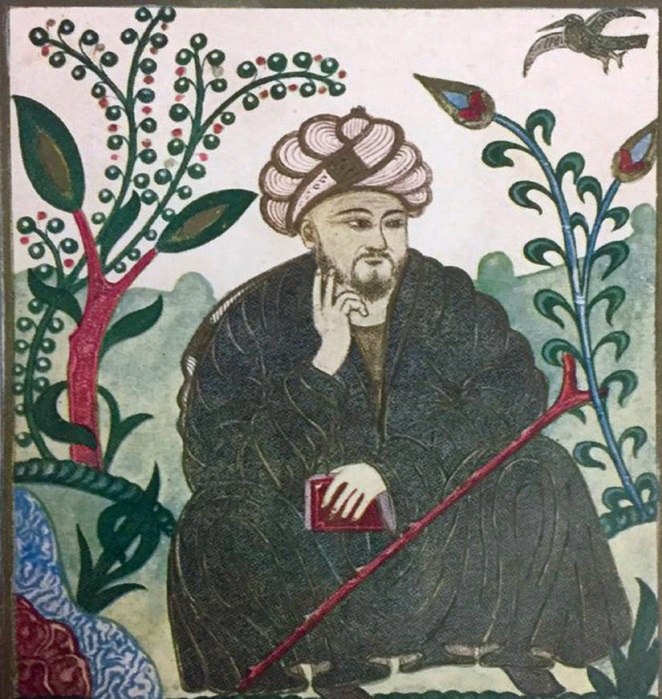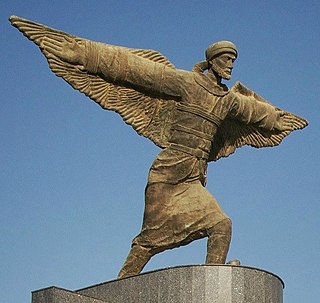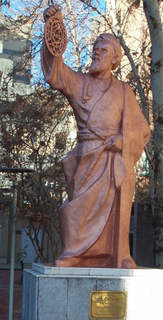 W
WAhmed Zaki Abu Shadi in Cairo, was an Egyptian Romantic poet, publisher, medical doctor, bacteriologist and bee scientist.
 W
WIbn Sina, also known as Abu Ali Sina, Pur Sina (پورسینا), and often known in the West as Avicenna, was a Persian polymath who is regarded as one of the most significant physicians, astronomers, thinkers and writers of the Islamic Golden Age, and the father of early modern medicine. Sajjad H. Rizvi has called Avicenna "arguably the most influential philosopher of the pre-modern era". He was a Muslim Peripatetic philosopher influenced by Aristotelian philosophy. Of the 450 works he is believed to have written, around 240 have survived, including 150 on philosophy and 40 on medicine.
 W
WAbū ʿAbd Allāh Muḥammad ibn Jābir ibn Sinān al-Raqqī al-Ḥarrānī aṣ-Ṣābiʾ al-Battānī was an Arab astronomer, and mathematician. He introduced a number of trigonometric relations, and his Kitāb az-Zīj was frequently quoted by many medieval astronomers, including Copernicus. Often called the "Ptolemy of the Arabs", al-Battani is perhaps the greatest and best known astronomer of the medieval Islamic world.
 W
WMīrzā Muhammad Tāraghay bin Shāhrukh, better known as Ulugh Beg, was a Timurid sultan, as well as an astronomer and mathematician.
 W
WAbu Rayhan al-Biruni was an Iranian scholar and polymath during the Islamic Golden Age. He has been variously called as the "founder of Indology", "Father of Comparative Religion", "Father of modern geodesy", and the first anthropologist.
 W
WAbu Nasr Al-Farabi was a renowned early Islamic philosopher and jurist who wrote in the fields of political philosophy, metaphysics, ethics and logic. He was also a scientist, cosmologist, mathematician and music theorist.
 W
WAbū al-ʿAbbās Aḥmad ibn Muḥammad ibn Kathīr al-Farghānī, also known as Alfraganus in the West, was an astronomer in the Abbasid court in Baghdad, and one of the most famous astronomers in the 9th century. Al-Farghani composed several works on astronomy and astronomical equipment that were widely distributed in Arabic and Latin and were influential to many scientists. His best known work, Kitāb fī Jawāmiʿ ʿIlm al-Nujūmi, was an extensive summary of Ptolemy's Almagest containing revised experimental data. Among those influenced by al-Farghani's works were Copernicus, who is said to have used al-Farghani’s calculation of the diameter of the Earth in his own calculations, and Christopher Columbus, who used the same calculation for his voyages to America. In addition to making substantial contributions to astronomy, al-Farghani also worked as an engineer, supervising construction projects on rivers in Cairo, Egypt. The lunar crater Alfraganus is named after him.
 W
WAbu al-Qasim Abbas ibn Firnas ibn Wirdas al-Takurini, also known as Abbas ibn Firnas, latinized Armen Firman, was an Andalusian polymath: an inventor, physician, chemist, engineer, Andalusian musician, and Arabic-language poet. He was reported to have experimented with a form of flight.
 W
WJābir ibn Ḥayyān, known by the kunyas Abū Mūsā or Abū ‘Abd Allāh and the nisbas al-Ṣūfī, al-Azdī, al-Kūfī, or al-Ṭūsī, is the supposed author of an enormous number and variety of works in Arabic often called the Jabirian corpus. The scope of the corpus is vast and diverse covering a wide range of topics, including alchemy, cosmology, numerology, astrology, medicine, magic, mysticism, and philosophy.
 W
WThe following is a list of inventions made in the medieval Islamic world, especially during the Islamic Golden Age, as well as in later states of the Age of the Islamic Gunpowders such as the Ottoman and Mughal empires.
 W
WMuḥammad ibn Mūsā al-Khwārizmī, Arabized as al-Khwarizmi and formerly Latinized as Algorithmi, was a Persian polymath who produced vastly influential works in mathematics, astronomy, and geography. Around 820 CE he was appointed as the astronomer and head of the library of the House of Wisdom in Baghdad.
 W
WAbu Yūsuf Yaʻqūb ibn ʼIsḥāq aṣ-Ṣabbāḥ al-Kindī was an Arab Muslim philosopher, polymath, mathematician, physician and musician. Al-Kindi was the first of the Islamic peripatetic philosophers, and is hailed as the "father of Arab philosophy".
 W
WAla al-Dīn Ali ibn Muhammed, known as Ali Qushji was a Timurid theologian, jurist, astronomer, mathematician and physicist, who settled in the Ottoman Empire some time before 1472. As a disciple of Ulugh Beg, he is best known for the development of astronomical physics independent from natural philosophy, and for providing empirical evidence for the Earth's rotation in his treatise, Concerning the Supposed Dependence of Astronomy upon Philosophy. In addition to his contributions to Ulugh Beg's famous work Zij-i-Sultani and to the founding of Sahn-ı Seman Medrese, one of the first centers for the study of various traditional Islamic sciences in the Ottoman caliphate, Ali Kuşçu was also the author of several scientific works and textbooks on astronomy.
 W
WAbū Bakr Muhammad Zakariyyā Rāzī or Rasis; 854–925 CE), was a Persian polymath, physician, alchemist, philosopher, and important figure in the history of medicine. He also wrote on logic, astronomy and grammar.
 W
WAhmed Muhiddin Piri, better known as Piri Reis, was an Ottoman admiral, navigator, geographer and cartographer. He is primarily known today for his maps and charts collected in his Kitab-ı Bahriye, a book that contains detailed information on early navigational techniques as well as relatively accurate charts for their time, describing the important ports and cities of the Mediterranean Sea.
 W
WMostafa A. El-Sayed ) is an Egyptian chemical physicist, a leading nanoscience researcher, a member of the National Academy of Sciences and a US National Medal of Science laureate. He is also known for the spectroscopy rule named after him, the El-Sayed rule.
 W
WʿAbu al-Ḥasan Alāʾ al‐Dīn ʿAlī ibn Ibrāhīm al-Ansari known as Ibn al-Shatir or Ibn ash-Shatir was an Arab astronomer, mathematician and engineer. He worked as muwaqqit in the Umayyad Mosque in Damascus and constructed a sundial for its minaret in 1371/72.
 W
WTaqi al-Din Muhammad ibn Ma'ruf ash-Shami al-Asadi (1526-1585) was an Ottoman polymath active in Cairo and Istanbul. He was the author of more than ninety books on a wide variety of subjects, including astronomy, clocks, engineering, mathematics, mechanics, optics and natural philosophy.
 W
WMuhammad ibn Muhammad ibn al-Hasan al-Tūsī, better known as Nasir al-Din al-Tusi, was a Persian polymath, architect, philosopher, physician, scientist, and theologian. Nasir al-Din al-Tusi was a well published author, writing on subjects of math, engineering, prose, and mysticism. Additionally, al-Tusi made several scientific advancements. In astronomy, al-Tusi created very accurate tables of planetary motion, an updated planetary model, and critiques of Ptolemaic astronomy. He also made strides in logic, mathematics but especially trigonometry, biology, and chemistry. Nasir al-Din al-Tusi left behind a great legacy as well. Some consider Tusi one of the greatest scientists of medieval Islam, since he is often considered the creator of trigonometry as a mathematical discipline in its own right. The Muslim scholar Ibn Khaldun (1332–1406) considered Tusi to be the greatest of the later Persian scholars. There is also reason to believe that he may have influenced Copernican heliocentrism.
 W
WAbu al-Hasan 'Ali ibn 'Abd al-Rahman ibn Ahmad ibn Yunus al-Sadafi al-Misri was an important Egyptian Muslim and mathematician, whose works are noted for being ahead of their time, having been based on meticulous calculations and attention to detail.
 W
WAbū Isḥāq Ibrāhīm ibn Yaḥyā al-Naqqāsh al-Zarqālī al-Tujibi ; also known as Al-Zarkali or Ibn Zarqala (1029–1087), was an Arab Muslim instrument maker, astrologer, and the most important astronomer from the western part of the Islamic world.
 W
WAhmed Hassan Zewail was an Egyptian-American chemist, known as the "father of femtochemistry". He was awarded the 1999 Nobel Prize in Chemistry for his work on femtochemistry and became the first Egyptian to win a Nobel Prize in a scientific field. He was the Linus Pauling Chair Professor of Chemistry, Professor of Physics, and the director of the Physical Biology Center for Ultrafast Science and Technology at the California Institute of Technology.